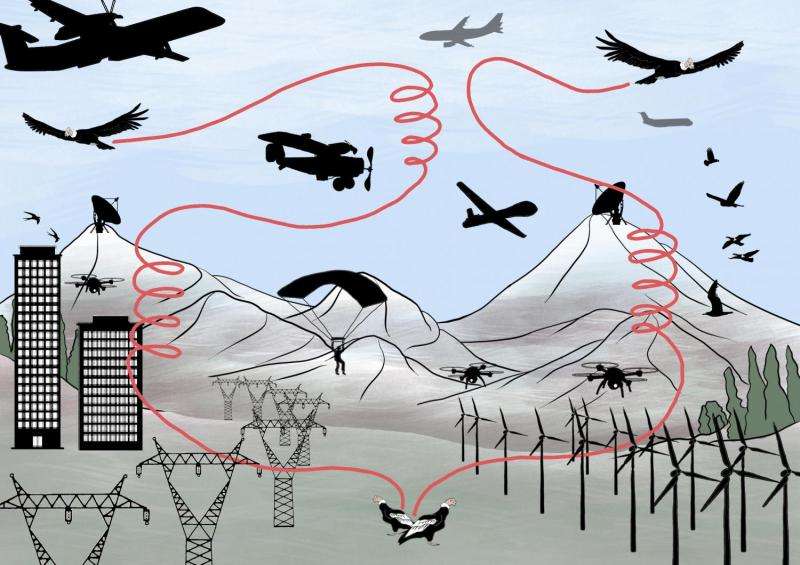May 1, 2015 report
Ecologist trio calls for efforts to mitigate human impact on flying animals

(Phys.org)—A trio of ecologists, one with Universidad Nacional del Comahue in Argentina and the other two with Swansea University in the U.K., has written and published a Perspective piece in the journal Science, calling for increased efforts to mitigate human caused deaths of flying animals. In their article, Sergio Lambertucci, Emily Shepard and Rory Wilson argue that not enough is being done to prevent the incidental deaths of wildlife that fly into buildings, airplanes or turbine blades.
The authors note that as human activities that infiltrate airspace have increased over the years, the result has been more animal deaths and disruptions that have led to lowered survival rates. The list includes such things as tall buildings, antennae, wind turbines, power lines and aircraft—including drones. They point out also that very few impact studies are done that take into consideration flying wildlife when human projects are undertaken and that aerial interactions between human constructs and wildlife are rarely considered as part of ecological consequences.
The result of ignoring human development on flying wildlife has led to the deaths of millions of animals worldwide and some human deaths as well, the authors claim, such as when birds smash through plane windows or get sucked into engines causing crashes. They suggest that mitigation efforts could reduce such casualties and reduce property losses—a glass additive that would allow birds to see skyscraper windows, is just one example. They point out that most human/wildlife aerial interaction occur relatively close to the ground, as that is where most birds fly, thus mitigation efforts need only concentrate on airspace approximately one hundred meters off the ground. They point out that some mitigation efforts would seem obvious, such as conducting a bird census in a given area before building an airport there.
The authors also note that some impacts on aerial wildlife are not so obvious, but should be taken into consideration nonetheless, such as the ways in which wind farms and buildings cause a change in local airflow patterns, which could cause problems for migrating species of birds. Human activities are also impacting aerial micro-biota, they note, which may in turn be having an impact on weather—such creatures serve as aerosols in cloud formation.
The authors conclude by suggesting we humans begin to think a little bit more about the impact of our activities on aerial biology and then, to devise strategies for mitigating the problem.
More information: Human-wildlife conflicts in a crowded airspace Science 1 May 2015: Vol. 348 no. 6234 pp. 502-504. DOI: 10.1126/science.aaa6743
Abstract
Over the past century, humans have increasingly used the airspace for purposes such as transportation, energy generation, and surveillance. Conflict with wildlife may arise from buildings, turbines, power lines, and antennae that project into space and from flying objects such as aircrafts, helicopters, and unmanned aerial vehicles (UAVs, or drones). The resulting collision and disturbance risks profoundly affect species ecology and conservation. Yet, aerial interactions between humans and wildlife are often neglected when considering the ecological consequences of human activities.
Journal information: Science
© 2015 Phys.org

















